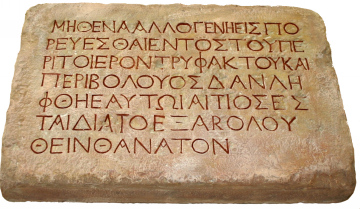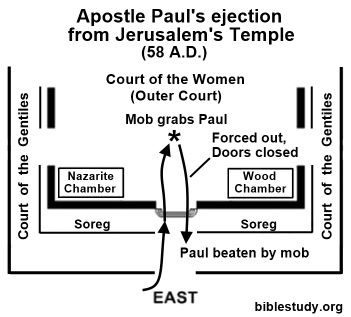"Men of Israel, help! This is the man who is teaching everyone everywhere against the people and the law and this place; and furthermore, he has also brought Greeks into the temple, and has defiled this holy place." (Acts 21:28, HBFV throughout).
Were these accusations true? Was Paul, who had trained to be a Pharisee (Acts 22:3, Philippians 3:4 - 6) and had an intimate knowledge of God's law, purposely defiling (desecrating) God's house of worship?
Background
In 58 A.D. Paul is in Jerusalem to celebrate the Feast of Pentecost (Acts 20:16). While he is in the city he meets with James (Jesus' half-brother) and other Christian elders (21:17 - 20). The concerned elders inform him that lies are circulating regarding what he teaches.
"But they (the Jews) have been informed that you are teaching all the Jews who are among the Gentiles to apostatize from Moses, telling them not to circumcise their children, nor to walk in the customs." (Acts 21:21).

within the balustrade round the temple and enclosure.
Whoever is caught will be responsible to himself
for his death, which will ensue.
In order to combat the lies the elders recommend Paul involve himself in several temple-centered customs to quell these rumors (Acts 21:23 - 24). He agrees to participate in a purification ritual with four Jewish Christians who have completed a Nazarite vow. The Apostle Paul also agrees to pay for their proscribed sacrifices and for their heads to be shaved (see Numbers 6:13 - 21).
Near the end of the purification ritual period Paul enters the temple's Court of the Gentiles with at least one other man (Acts 21:29). They then proceed past a fence known as the Soreg on their way inside God's house.
Warning Signs
The Soreg was a "reticulated fence of sticks" that was 10 handbreadths high (2.5 feet or 76 centimeters) which stood 10 cubits (14.6 to 17 feet or 4.45 to 5.18 meters) away from the temple's outer wall (1906 Jewish Encyclopedia). Edersheim's research stated the fence, which he labeled a "marble screen," was 4.5 feet (1.37 meters) high (The Temple at the Time of Christ by Edersheim, page 46).
Placed along the Soreg were signs, written in Koine Greek and Latin, with an ominous warning. One of these signs was found, in 1871 A.D., near the temple mount in Jerusalem. The limestone tablet, created between 23 B.C. and 70 A.D., had letters that were originally filled in with red paint.
The deadly serious sign warned that any stranger (an uncircumcised Gentile) who proceeded further into the complex, which was forbidden, would pay with their life.
A Riotous Time
As Paul passed the Soreg and entered the temple's Outer Court (Court of the Women), Jews from Asia believe one of the men accompanying him is a Gentile named Trophimus. Knowing that Gentiles are not allowed in Jerusalem's temple (see Ezekiel 44:7, 9) because they would defile it, they scream for help (Acts 21:28).

A mob quickly forms, grabs Paul, and forces him back into the Court of the Gentiles (Acts 21:30). Those who are in charge of the temple's Eastern (main) entrance, fearful that bloodshed would ensue that would pollute the holy place, close its giant doors. The apostle is beaten mercilessly until the Romans show up to halt the mayhem and arrest him (verses 31 - 32).
Conclusion
Jews from Asia, who like Paul were in Jerusalem to keep Pentecost, knew of and resented him due to his three-year evangelistic stay in Ephesus (Acts 19). They also knew Trophimus who was a resident of the metropolis (Acts 21:29). Their resentment of the gospel and the success it experienced led to them falsely accusing him of defiling the temple. They set in motion a series of events that would lead to Apostle Paul being tried before Caesar in Rome a few years later.